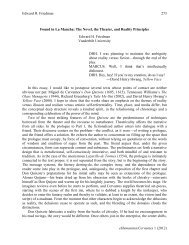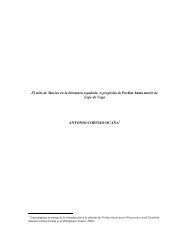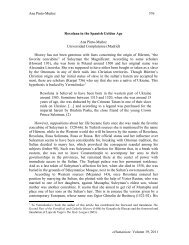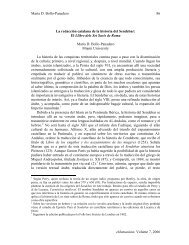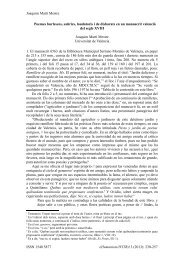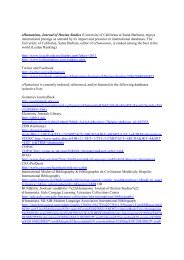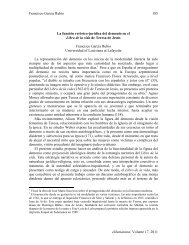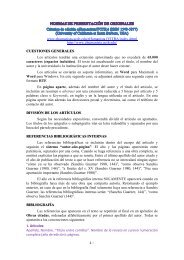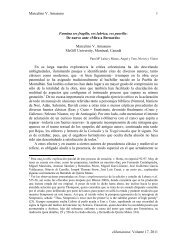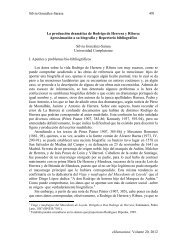Gregory Peter Andrachuk eHumanista: Volume 17, 2011 540 Alonso ...
Gregory Peter Andrachuk eHumanista: Volume 17, 2011 540 Alonso ...
Gregory Peter Andrachuk eHumanista: Volume 17, 2011 540 Alonso ...
You also want an ePaper? Increase the reach of your titles
YUMPU automatically turns print PDFs into web optimized ePapers that Google loves.
<strong>Gregory</strong> <strong>Peter</strong> <strong>Andrachuk</strong><br />
historical in the naming of persons and events, as though the author were telling the<br />
reader that the time for frivolity and excess has passed –or rather, should have passed. 3<br />
Ramón Folch de Cardona is connected directly with Vasquirán at several points in<br />
the narrative. The first instance occurs immediately after Vasquirán arrives in<br />
Noplesano (Naples). His initial social contacts are significant in establishing<br />
Vasquirán’s place within the society of the Neapolitan court, a point that would not be<br />
lost on his intended readership. Thus his visit to the residence of two of the grandes<br />
dames of Naples, the Duquesa de Meliano, that is, the Duchess of Milan, Isabel de<br />
Aragona, widow of Gian Galeazzo Sforza, and her daughter Belisena, that is, Bona<br />
Sforza, is not simply the correct thing to do. It also provides the author with an<br />
opportunity to identify the social status of Vasquirán within a highly structured<br />
society. 4 The greeting given him by the Duchess makes clear the social position of<br />
Vasquirán as well as the long-standing relationship he has had with this family for she<br />
speaks in terms which go beyond the merely formulaic, referring to “el valer y virtud y<br />
criança tuya” as well as “ell amor y voluntad que al duque mi señor...y a mi casa<br />
siempre te conocí tener” (121 and 122). A similar familiarity, affection and<br />
affirmation of social standing is shown to Vasquirán immediately afterwards as he<br />
visits the viceregal residence of Castel Nuovo where he meets informally with the<br />
highest representatives of both state and Church: the Viceroy Ramón de Cardona, the<br />
Cardenal de Brujas (Luis de Borja, Archbishop of Valencia) and the Cardenal de<br />
Felernisa (Francisco de Remolines, Archbishop of Sorrento) 5 “los quales con mucho<br />
amor le recibieron” (123). These two visits serve as definite indicators of the social<br />
rank of Vasquirán and of the real person this character represents. Lest the reader miss<br />
the significance of these encounters the author very quickly reinforces the message:<br />
Vasquirán, his friend Flamiano, and the Cardenal de Brujas (“vn notable cauallero y<br />
mancebo y tan inclinado a las cosas de cauallería” [135]) together make another visit<br />
to the palace of the Viceroy where they are received “con mucho plazer” (136) and<br />
where all four closet themselves in the Viceroy’s private chambers to plan the tela de<br />
justa real. Thus we see that Vasquirán (and the person he represents) is fully accepted<br />
3 The significance of this shift from fiction to reality has been explored more fully elsewhere<br />
(<strong>Andrachuk</strong> 1997). The very detailed description of the Viceroy’s lavish spending on appearance and<br />
comfort in his preparations for war forms the core of the social commentary in this work and may be<br />
related to the author’s anonymity.<br />
4 The text is quite explicit about his intentions: “acordó de yr a besar las manos a la señora duquesa de<br />
Meliano y ha Belisena, y después al visorey y al cardenal de Brujas…que sus estados y la razón lo<br />
requerría” (120).<br />
5 There are sound elements in the text at this point (as there are elsewhere in the text) which I believe<br />
are designed to suggest the identity of Vasquirán as a Cardona. One of these is the gratuitous mention of<br />
the Marqués Carlerín who accompanied Flamiano to greet his friend Vasquirán as he arrived in Naples<br />
and who now accompanies him to visit the Duchess, remaining behind while Vasquirán goes on to visit<br />
the Viceroy, Ramón de Cardona, and where he meets also the Cardenal de Brujas and the Cardenal de<br />
Felernisa. This is just one element in the accumulation of clues which together lead to the identification<br />
of the author.<br />
542<br />
<strong>eHumanista</strong>: <strong>Volume</strong> <strong>17</strong>, <strong>2011</strong>



